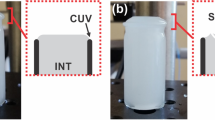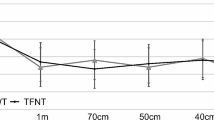Abstract
Purpose
We aim to improve contact lens fitting by using an innovative and simple photogrammetry imaging system to find the sagittal height (SAG) of soft contact lenses.
Methods
Eleven different types of commercially available soft contact lenses were measured, and five different lenses per package of each lens type were evaluated. The lenses were inserted in a polymethyl methacrylate cell with parallel faces containing a solution of saline and fluorescein to improve the contrast against the background. For every lens, two photographs from the top view and five photographs from the side view were taken. Using homothetic transformations, we calculated the sagittal height.
Results
The SAG of all lenses ranged from 3450 to 3907 μm. Differences can be appreciated between SAG of different materials. Performing an ANOVA test, we confirm that the intra-packaging sagitta is reliable for every lens. Comparing the measured SAG with the calculated spherical one, we confirm that the majority of lenses, eight out of eleven, have a spherical geometry for the internal side. Finally, we are able to group the type of lenses that present similar SAG apart from the data reported on the blister.
Conclusion
Optical coherence tomography measurement of the eye sagitta over a given chord helped finding the first lens to fit, because matching contact lens sagitta and ocular sagitta is the key for a good fitting. In our work, we found that the majority of brands use single sphere geometry for internal surface of disposable soft contact lenses.



Similar content being viewed by others
References
Ţălu SD (2005) Ophtalmologie—cours, medical publishing house. Iuliu Haţieganu, Cluj-Napoca
Childs A, Li H, Lewittes DM, Dong B, Liu W, Shu X, Sun C, Zhang HF (2016) Fabricating customized hydrogel contact lens. Sci Rep 6:34905. https://doi.org/10.1038/srep34905
Ţălu Ş, Ţălu M, Giovanzana S, Shah R (2011) A brief history of contact lenses. HVM Bioflux 3(1):33–37
Efron N (2010) Contact lens practice, 2nd edn. Butterworth Heinemann Elsevier, Oxford
Ţălu Ş (2013) Characterization of surface roughness of unworn hydrogel contact lenses at a nanometric scale using methods of modern metrology. Polym Eng Sci 53:2141–2150
Douthwaite WA (2006) Contact lens optics and lens design, 3rd edn. Butterworth Heinemann Elsevier, Oxford
Ţălu Ş, Stępień K, Caglayan MO (2015) Topographic characterization of unworn contact lenses assessed by atomic force microscopy and wavelet transform. Microsc Res Tech 78:1026–1031
Ţălu Ş, Stach S (2014) Multifractal characterization of unworn hydrogel contact lens surfaces. Polym Eng Sci 54:1066–1080
Ţălu Ş (2012) Texture analysis methods for the characterisation of biological and medical images. ELBA Bioflux 4(1):8–12
Ţălu Ş, Bramowicz M, Kulesza S, Fiorillo I, Giovanzana S (2017) Fractal features and surface micromorphology of unworn surfaces of rigid gas permeable contact lenses. Curr Eye Res 42(8):1118–1123
Filipecki J, Sitarz M, Kocela A, Kotynia K, Jelen P, Filipecka K, Gaweda M (2014) Studying functional properties of hydrogel and silicone-hydrogel contact lenses with PALS, MIR and Raman spectroscopy. Spectrochim Acta A Mol Biomol Spectrosc 131:686–690
Ţălu Ş (2012) Mathematical methods used in monofractal and multifractal analysis for the processing of biological and medical data and images. Anim Biol Anim Husb 4(1):1–4
Young G (1992) Ocular sagittal height and soft contact lens fit. J BCLA 15:45–49
Young G (2014) Mathematical model for evaluating soft contact lens fit. Optom Vis Sci 91:167–176
Van der Worp E (2010) A guide to scleral lens fitting. Pacific University, Forest Grove
Hall LA, Hunt C, Young G, Wolffsohn J (2013) Factors affecting corneoscleral topography. Invest Ophthalmol Vis Sci 54:3691–3701
Bibby MM (1979) Sagittal depth considerations in the selection of the base curve radius of a soft contact lens. Am J Optom Vis Sci 56:407–413
Hall LA, Young G, Wolffsohn JS, Riley C (2011) The influence of corneoscleral topography on soft contact lens fit. Invest Ophthalmol Vis Sci 52:6801–6806
Young G, Schnider C, Hunt C, Efron S (2010) Corneal topography and soft contact lens fit. Optom Vis Sci 87:358–366
Sorbara L, Maram J, Fonn D, Woods C, Simpson T (2010) Metrics of the normal cornea: anterior segment imaging with the Visante OCT. Clin Exp Optom 93:150–156
Luhmann T, Robson S, Kyle SA, Harley IA (2007) Close range photogrammetry: principles, techniques and applications. Whittles, Dunbeath
Ţălu Ş (2015) Micro and nanoscale characterization of three dimensional surfaces. Basics and applications. Napoca Star Publishing House, Cluj-Napoca
Phillips AJ, Speedwell L (2018) Contact lenses e-book. Elsevier Health Sciences, Oxford
Van der Worp E, Mertz C (2015) Sagittal height differences of frequent replacement silicone hydrogel contact lenses. Contact Lens Anterio 38:157–162
Acknowledgements
We thank Claudio Iovine (Università degli Studi di Milano-Bicocca, Milano, Italia) and Marta Farioli (Ottica Benzoni, Malnate, Italia) for their help in finding the soft contact lenses on the market.
Author information
Authors and Affiliations
Corresponding author
Ethics declarations
Conflict of interest
The authors declare that they have no conflict of interest.
Additional information
Publisher's Note
Springer Nature remains neutral with regard to jurisdictional claims in published maps and institutional affiliations.
Rights and permissions
About this article
Cite this article
Giovanzana, S., Ţălu, Ş. & Nicoară, S.D. Sagittal height differences of disposable soft contact lenses. Int Ophthalmol 40, 459–465 (2020). https://doi.org/10.1007/s10792-019-01206-5
Received:
Accepted:
Published:
Issue Date:
DOI: https://doi.org/10.1007/s10792-019-01206-5




